Yijin Pan
Spatial Bandwidth of Bilateral Near-Field Channels for Linear Large-Scale Antenna Array System
Dec 06, 2024



Abstract:This paper analyzes the spatial bandwidth of line-of-sight (LoS) channels in massive MIMO systems. For the linear large-scale antenna arrays (LSAA) of transceivers placed in random locations in 3D space, a simple but accurate closed-form expression is derived to characterize the spatial bandwidth. Subsequent analysis of the LSAA's spatial bandwidth properties is also provided, leading to the formulation of an approximate expression for the effective degrees of freedom (EDoF) of bilateral near-field channels. Interestingly, as proved in this work, when the transmit and receive arrays are coplanar, with the receive array positioned perpendicular to the axis joining the centroids of the transmit and receive arrays, the EDoF of the LoS channel is found to be approximately maximized.
Paving the Way to 6G: Outage Probability Analysis for FAS-ARIS Systems
Nov 03, 2024

Abstract:In this paper, we pave the way to six-generation (6G) by investigating the outage probability (OP) of fluid antenna system (FAS)-active reconfigurable intelligent surface (ARIS) communication systems. We consider a FAS-ARIS setup consisting of a base station (BS) with a single fixed-position antenna and a receiver equipped with a fluid antenna (FA). Utilizing the block-correlation model, we derive a closed-form expression for the OP. Our analysis, supported by numerical results, confirms the accuracy and effectiveness of the derivation. Furthermore, the results demonstrate that the FAS-ARIS system significantly outperforms other configurations in terms of OP, highlighting its potential to enhance communication performance and reliability in future 6G networks.
Spatial Non-Stationary Dual-Wideband Channel Estimation for XL-MIMO Systems
Jul 08, 2024Abstract:In this paper, we investigate the channel estimation problem for extremely large-scale multi-input and multi-output (XL-MIMO) systems, considering the spherical wavefront effect, spatially non-stationary (SnS) property, and dual-wideband effects. To accurately characterize the XL-MIMO channel, we first derive a novel spatial-and-frequency-domain channel model for XL-MIMO systems and carefully examine the channel characteristics in the angular-and-delay domain. Based on the obtained channel representation, we formulate XL-MIMO channel estimation as a Bayesian inference problem. To fully exploit the clustered sparsity of angular-and-delay channels and capture the inter-antenna and inter-subcarrier correlations, a Markov random field (MRF)-based hierarchical prior model is adopted. Meanwhile, to facilitate efficient channel reconstruction, we propose a sparse Bayesian learning (SBL) algorithm based on approximate message passing (AMP) with a unitary transformation. Tailored to the MRF-based hierarchical prior model, the message passing equations are reformulated using structured variational inference, belief propagation, and mean-field rules. Finally, simulation results validate the convergence and superiority of the proposed algorithm over existing methods.
Spatially Non-Stationary XL-MIMO Channel Estimation: A Three-Layer Generalized Approximate Message Passing Method
Mar 05, 2024



Abstract:In this paper, channel estimation problem for extremely large-scale multi-input multi-output (XL-MIMO) systems is investigated with the considerations of the spherical wavefront effect and the spatially non-stationary (SnS) property. Due to the diversities of SnS characteristics among different propagation paths, the concurrent channel estimation of multiple paths becomes intractable. To address this challenge, we propose a two-phase channel estimation scheme. In the first phase, the angles of departure (AoDs) on the user side are estimated, and a carefully designed pilot transmission scheme enables the decomposition of the received signal from different paths. In the second phase, the subchannel estimation corresponding to different paths is formulated as a three-layer Bayesian inference problem. Specifically, the first layer captures block sparsity in the angular domain, the second layer promotes SnS property in the antenna domain, and the third layer decouples the subchannels from the observed signals. To efficiently facilitate Bayesian inference, we propose a novel three-layer generalized approximate message passing (TL-GAMP) algorithm based on structured variational massage passing and belief propagation rules. Simulation results validate the convergence and effectiveness of the proposed algorithm, showcasing its robustness to different channel scenarios.
Joint User Scheduling and Computing Resource Allocation Optimization in Asynchronous Mobile Edge Computing Networks
Jan 21, 2024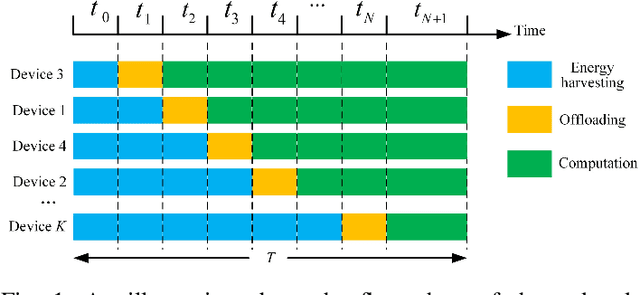
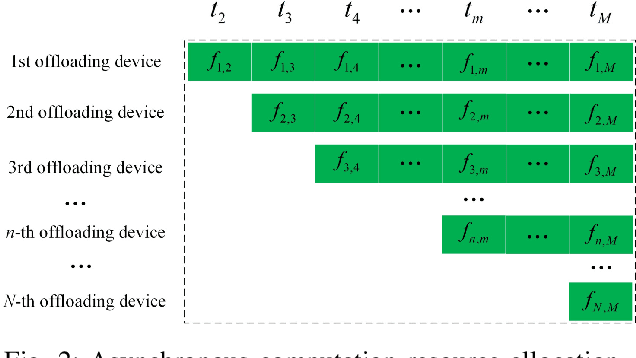
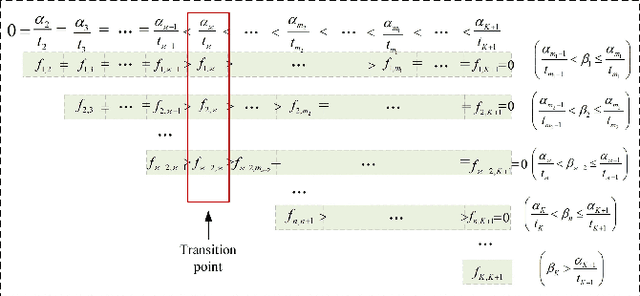
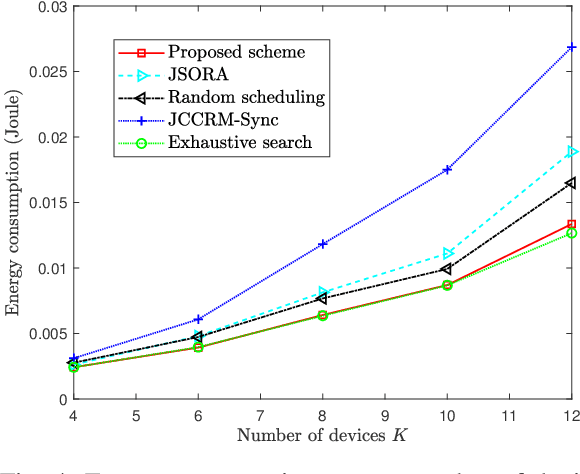
Abstract:In this paper, the problem of joint user scheduling and computing resource allocation in asynchronous mobile edge computing (MEC) networks is studied. In such networks, edge devices will offload their computational tasks to an MEC server, using the energy they harvest from this server. To get their tasks processed on time using the harvested energy, edge devices will strategically schedule their task offloading, and compete for the computational resource at the MEC server. Then, the MEC server will execute these tasks asynchronously based on the arrival of the tasks. This joint user scheduling, time and computation resource allocation problem is posed as an optimization framework whose goal is to find the optimal scheduling and allocation strategy that minimizes the energy consumption of these mobile computing tasks. To solve this mixed-integer non-linear programming problem, the general benders decomposition method is adopted which decomposes the original problem into a primal problem and a master problem. Specifically, the primal problem is related to computation resource and time slot allocation, of which the optimal closed-form solution is obtained. The master problem regarding discrete user scheduling variables is constructed by adding optimality cuts or feasibility cuts according to whether the primal problem is feasible, which is a standard mixed-integer linear programming problem and can be efficiently solved. By iteratively solving the primal problem and master problem, the optimal scheduling and resource allocation scheme is obtained. Simulation results demonstrate that the proposed asynchronous computing framework reduces 87.17% energy consumption compared with conventional synchronous computing counterpart.
Joint Visibility Region and Channel Estimation for Extremely Large-scale MIMO Systems
Nov 16, 2023Abstract:In this work, we investigate the channel estimation (CE) problem for extremely large-scale multiple-input-multiple-output (XL-MIMO) systems, considering both the spherical wavefront effect and spatial non-stationarity (SnS). Unlike existing non-stationary CE methods that rely on the statistical characteristics of channels in the spatial or temporal domain, our approach seeks to leverage sparsity in both the spatial and wavenumber domains simultaneously to achieve an accurate estimation.To this end, we introduce a two-stage visibility region (VR) detection and CE framework. Specifically, in the first stage, the belief regarding the visibility of antennas is obtained through a structured message passing (MP) scheme, which fully exploits the block sparse structure of the antenna-domain channel. In the second stage, using the obtained VR information and wavenumber-domain sparsity, we accurately estimate the SnS channel employing the belief-based orthogonal matching pursuit (BB-OMP) method. Simulations demonstrate that the proposed algorithms lead to a significant enhancement in VR detection and CE accuracy, especially in low signal-to-noise ratio (SNR) scenarios.
Channel Tracking for RIS-aided mmWave Communications Under High Mobility Scenarios
Nov 07, 2022
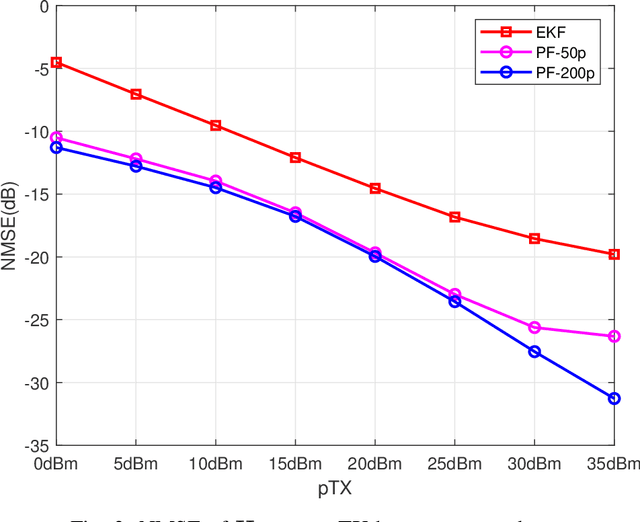
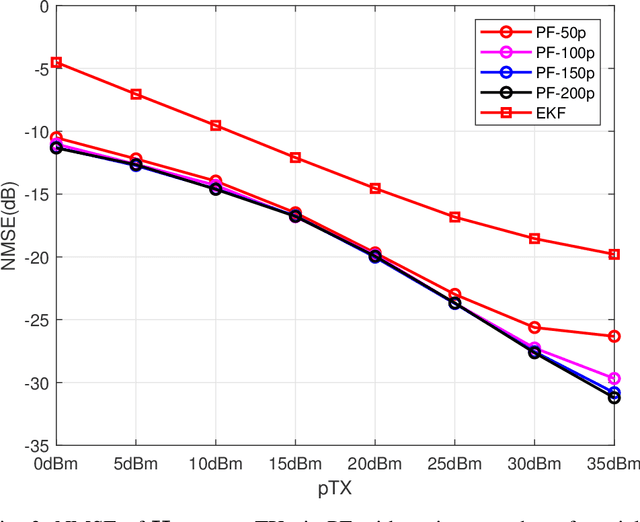
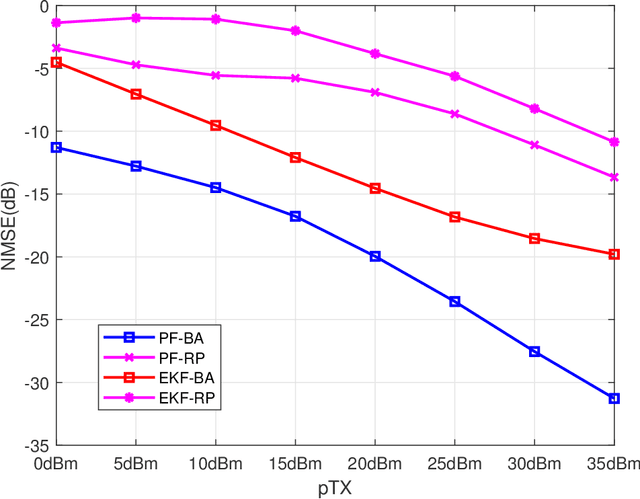
Abstract:The emerging reconfigurable intelligent surface (RIS) technology is promising for applications in the millimeter wave (mmWave) communication systems to effectively compensate for propagation loss or tackle the blockage issue. Considering the high mobility of users in realistic scenarios, it is essential to adjust the phase shifts in real time to align the beam towards the mobile users, which requires to frequently estimate the channel state information. Hence, it is imperative to design efficient channel tracking schemes to avoid the complex channel estimation procedure. In this paper, we develop a novel channel tracking scheme with two advantages over conventional schemes. First, our tracking scheme is based on the cascaded angles at the RIS instead of the accurate angle values, which is more practical. Second, it can be employed under a more general setting where the noise can be non-Gaussian. Simulation results show the high tracking accuracy of our proposed scheme, and validate the superiority to the existing EKF-based tracking scheme.
Joint Channel Estimation and Localization in the Near Field of RIS Enabled mmWave/subTHz Communications
Aug 24, 2022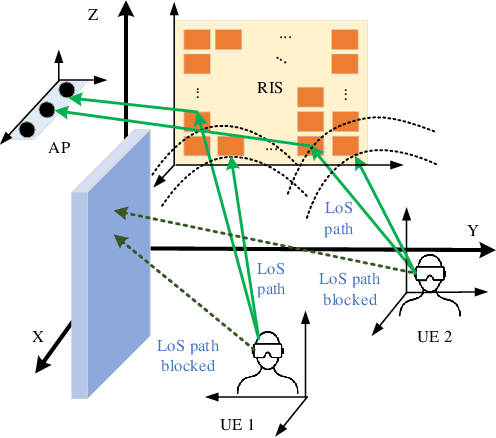
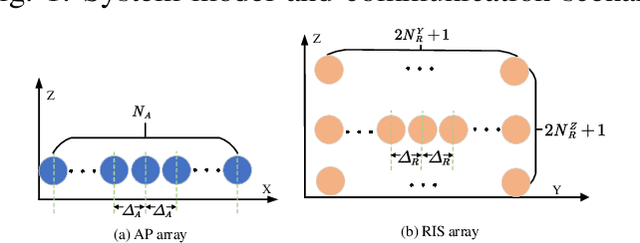
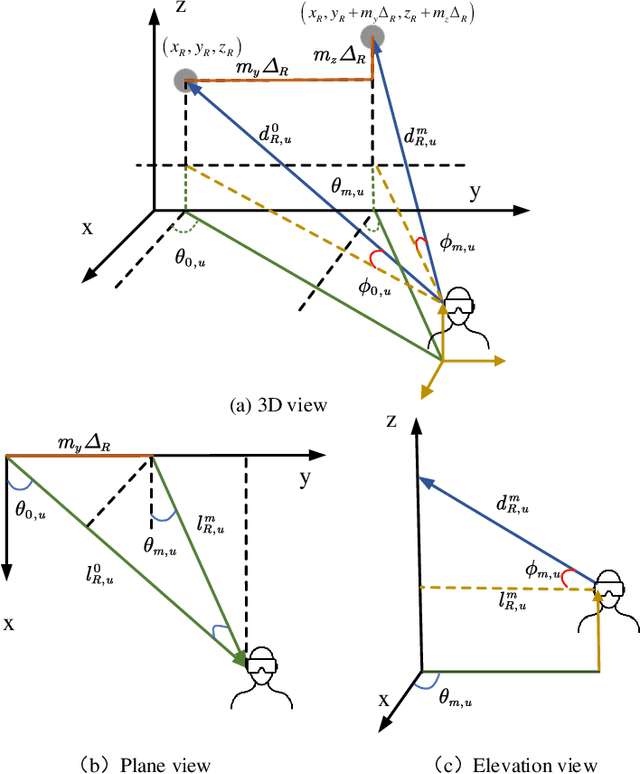
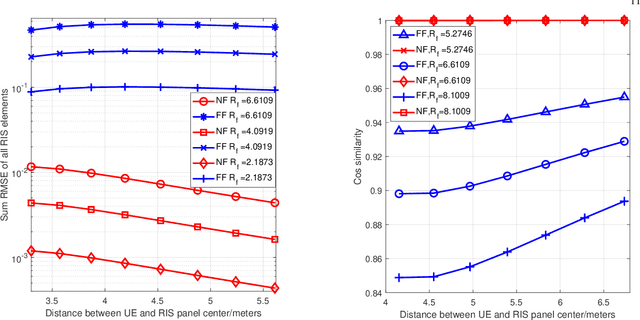
Abstract:Reconfigurable intelligent surface (RIS) makes it possible to create an intelligent electromagnetic environment. The low hardware cost makes ultra-large (XL) RIS an attractive performance enhancement scheme, but it brings the challenge of near-field propagation channels. This makes the localization and channel estimation more complicated. In this paper, we consider the spherical wavefront propagation in the near field of the millimeter-wave/sub-Terahertz (mmWave/subTHz) localization system with the assistance of a RIS. A near-field joint channel estimation and localization (NF-JCEL) algorithm is proposed based on the derived second-order Fresnel approximation of the near-field channel model. To be specific, we first decouple the user equipment (UE) distances and angles of arrival (AoAs) through a down-sampled Toeplitz covariance matrix, so that the vertical and azimuth AoAs in the array steering vectors can be estimated separately with low complexities. Then, the UE distance can be estimated by the simple one-dimensional search, and the channel attenuation coefficients are obtained through the orthogonal matching pursuit (OMP) method. Simulation results validate the superiority of the proposed NF-JCEL algorithm to the conventional far-field algorithm, and show that higher resolution accuracy can be obtained by the proposed algorithm.
Two-Step mmWave Positioning Scheme with RIS-Part II: Position Estimation and Error Analysis
Aug 16, 2022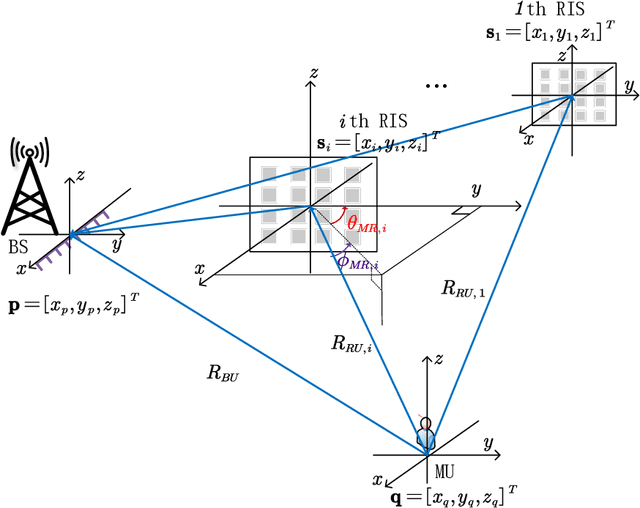
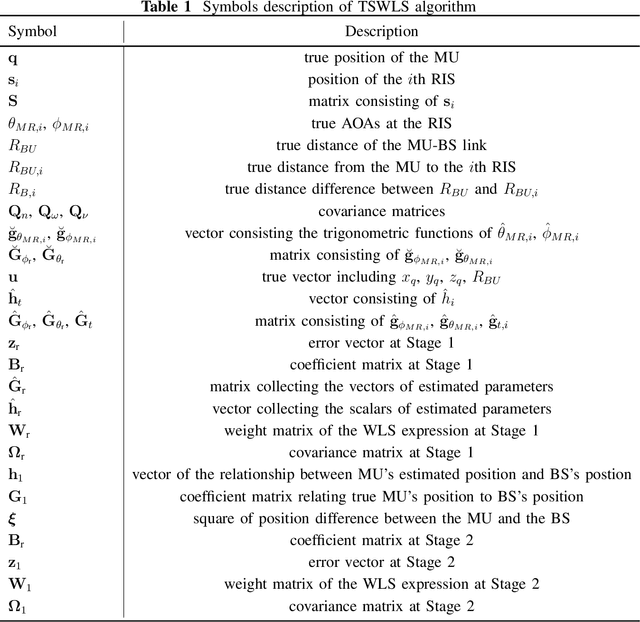

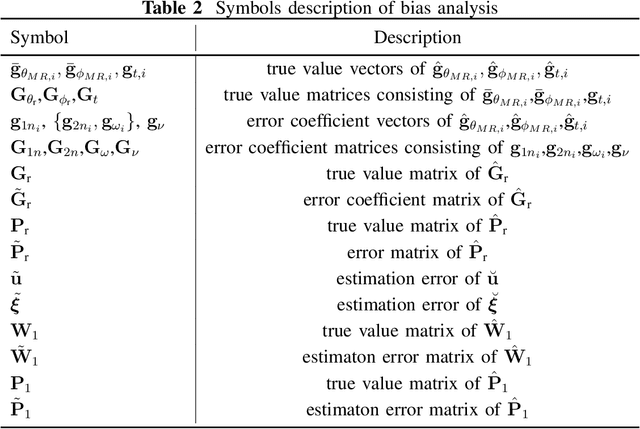
Abstract:In this series of work, we propose a comprehensive two-step three-dimensional (3D) positioning scheme in a millimeter wave (mmWave) system, where the reconfigurable intelligent surface (RIS) is leveraged to enhance the positioning performance of mobile users (MUs). Specifically, the first step is the estimation error modeling and analysis, while the second step is the corresponding positioning algorithm design and bias analysis. The first step is introduced in Part I of this series of work, and the second step is investigated in this paper. Our aim in this series of work is to obtain the closed-form solution of the MU's position through a two-stage weight least square (TSWLS) algorithm. In the first stage, we construct the pseudolinear equations based on the angle of arrival (AOA) and the time difference of arrival (TDOA) estimation at the RISs, then we obtain a preliminary estimation by solving these equations using the weight least square (WLS) method. Based on the preliminary estimation in the first stage, a new set of pseudolinear equations are obtained, and a finer estimation is obtained by solving the equations using the WLS method in the second stage. By combining the estimation of both stages, the final estimation of the MU's position is obtained. Further, we study the theoretical bias of the proposed algorithm by considering the estimation error in both stages. Simulation results demonstrate the superiority of the proposed positioning scheme.
Two-Step mmWave Positioning Scheme with RIS-Part I: Angle Estimation and Analysis
Aug 16, 2022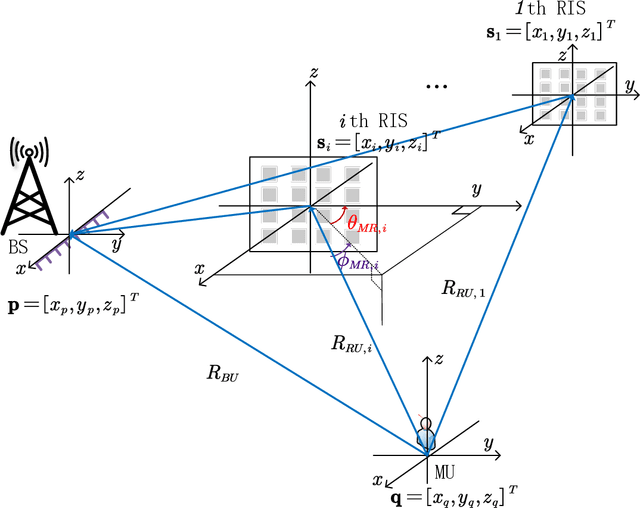
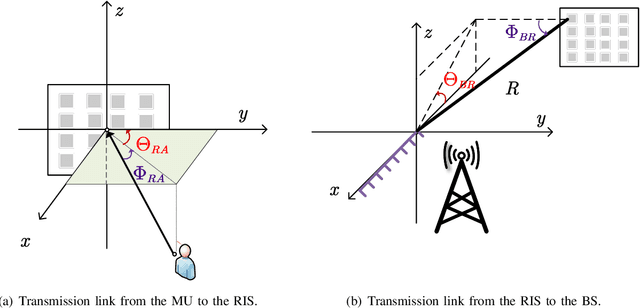
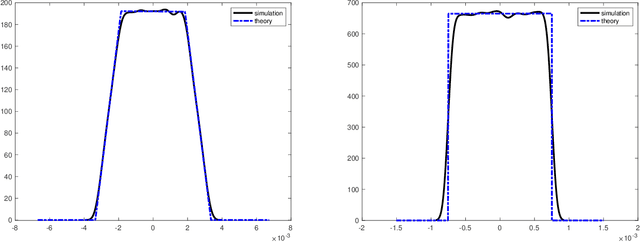
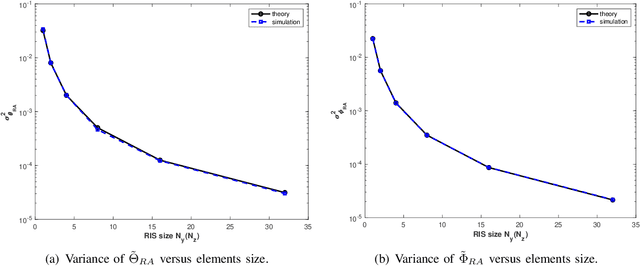
Abstract:In this series of work, we propose a comprehensive two-step three-dimensional (3D) positioning scheme in a millimeter wave (mmWave) system, where the reconfigurable intelligent surface (RIS) is leveraged to enhance the positioning performance of mobile users (MUs). Specifically, the first step is the estimation error modeling and analysis based on the two-dimensional discrete Fourier transform (2D-DFT) angle estimation technique, while the second step is the corresponding positioning algorithm design and bias analysis. The first step is introduced in this paper, and the second step is investigated in Part II of this series work. Based on 2D-DFT angle estimation, the angle estimation error is modeled and analyzed by deriving its probability density functions (PDF). More specifically, we first derive the PDF by using the geometric relationship between the angles of arrival (AOAs) and their triangle functions. Then, we simplify the intricate expression of the PDF of the AOA estimation error by employing the first-order linear approximation of triangle functions. Finally, we derive a complex expression for the variance based on the derived PDF. Distinctively, for the azimuth estimation error, the variance is separately integrated according to the different non-zero intervals of the PDF, which will be used in the second part of this series work for the analysis of the position estimation error. Extensive simulation results are also presented to verify the accuracy of the derived results.
 Add to Chrome
Add to Chrome Add to Firefox
Add to Firefox Add to Edge
Add to Edge